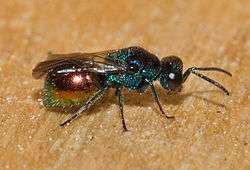Pseudomalus auratus
| Pseudomalus auratus | |
|---|---|
 | |
| A live individual of Pseudomalus auratus | |
| | |
| Pseudomalus auratus. Museum specimen | |
| Scientific classification | |
| Kingdom: | Animalia |
| Phylum: | Arthropoda |
| Class: | Insecta |
| Order: | Hymenoptera |
| Family: | Chrysididae |
| Genus: | Pseudomalus |
| Species: | P. auratus |
| Binomial name | |
| Pseudomalus auratus (Linnaeus, 1758) | |
| Synonyms | |
| |
Pseudomalus auratus is a species of cuckoo wasp (the family Chrysididae). [1]
Description
Pseudomalus auratus can reach a length of 3–7 millimetres (0.12–0.28 in). Head and thorax of these little wasps are metallic bluish, while the abdomen is reddish. Head and thorax are hairy. [2][3]
Biology
These wasps fly from late May to early October. [2] They mainly parasitize hymenoptera in the Apidae family (Ceratina), Colletidae family (Hylaeus), Megachilidae family (Anthidium) and in the Crabronidae family (Pemphredon lethifera, Pemphredon unicolor, Passaloecus gracilis, Passaloecus turionum, Passaloecus brevicornis, Rhopalum coarctatum, Psenulus and Trypoxylon). [2] Larvae mainly can be found in blackberry and raspberry branches and dead wood. [2][3]
Distribution and habitat
This species is present in most of Europe (UK, Norway, Sweden, Finland, Denmark, Belgium, France, Spain, Germany, Italy, Poland, Hungary, former Yugoslavia, Greece, Canary Islands, Crete and Switzerland, in the East Palearctic ecozone, in the Near East, in North Africa and in Asia (including Russia, Manchuria, Korea and Japan). [2][4] These wasps inhabit open areas, forest edges and thickets where its nesting hosts can be found. [2]
Bibliography
- Rolf Witt: Wespen. Beobachten, Bestimmen. Naturbuch-Verlag, Augsburg 1998, ISBN 3-89440-243-1.